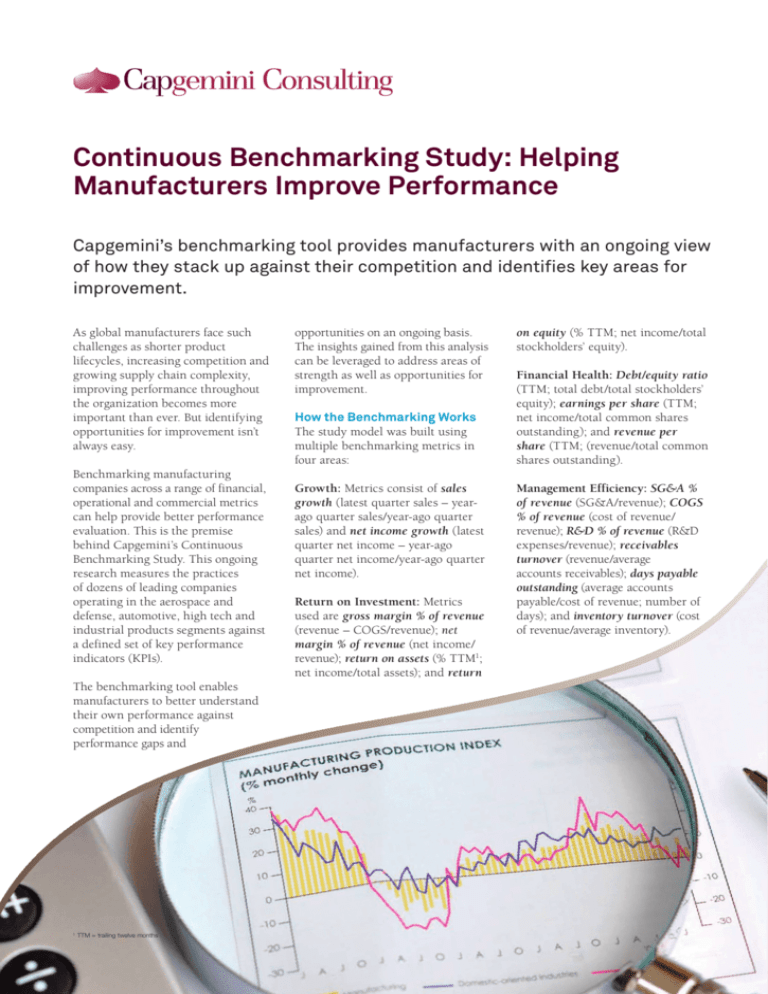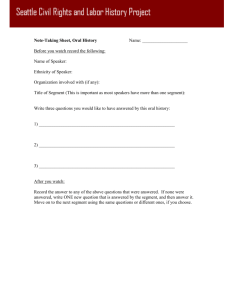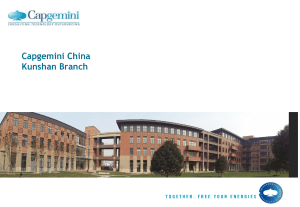
Client Logo
Continuous Benchmarking Study: Helping
Manufacturers Improve Performance
Capgemini’s benchmarking tool provides manufacturers with an ongoing view
of how they stack up against their competition and identifies key areas for
improvement.
As global manufacturers face such
challenges as shorter product
lifecycles, increasing competition and
growing supply chain complexity,
improving performance throughout
the organization becomes more
important than ever. But identifying
opportunities for improvement isn’t
always easy.
Benchmarking manufacturing
companies across a range of financial,
operational and commercial metrics
can help provide better performance
evaluation. This is the premise
behind Capgemini’s Continuous
Benchmarking Study. This ongoing
research measures the practices
of dozens of leading companies
operating in the aerospace and
defense, automotive, high tech and
industrial products segments against
a defined set of key performance
indicators (KPIs).
The benchmarking tool enables
manufacturers to better understand
their own performance against
competition and identify
performance gaps and
1
TTM = trailing twelve months
opportunities on an ongoing basis.
The insights gained from this analysis
can be leveraged to address areas of
strength as well as opportunities for
improvement.
How the Benchmarking Works
The study model was built using
multiple benchmarking metrics in
four areas:
Growth: Metrics consist of sales
growth (latest quarter sales – yearago quarter sales/year-ago quarter
sales) and net income growth (latest
quarter net income – year-ago
quarter net income/year-ago quarter
net income).
Return on Investment: Metrics
used are gross margin % of revenue
(revenue – COGS/revenue); net
margin % of revenue (net income/
revenue); return on assets (% TTM1;
net income/total assets); and return
on equity (% TTM; net income/total
stockholders’ equity).
Financial Health: Debt/equity ratio
(TTM; total debt/total stockholders’
equity); earnings per share (TTM;
net income/total common shares
outstanding); and revenue per
share (TTM; (revenue/total common
shares outstanding).
Management Efficiency: SG&A %
of revenue (SG&A/revenue); COGS
% of revenue (cost of revenue/
revenue); R&D % of revenue (R&D
expenses/revenue); receivables
turnover (revenue/average
accounts receivables); days payable
outstanding (average accounts
payable/cost of revenue; number of
days); and inventory turnover (cost
of revenue/average inventory).
Figure 1: Continuous Benchmarking Model (Selected Benchmarks)
Growth
Return on Investment
1. Sales Growth
2.
Net Income
Growth
Financial Health
Growth and ROI
Receivables
Turnover
Gross Margin
% of Revenue
5.
Return on
Assets (% TTM)
7.
4.
Net Margin
% of Revenue
6.
Return on
Equity (% TTM)
8. Earnings per
Share $ (TTM)
11. COGS % of
Revenue
14. Days Payable
Outstanding
Revenue per
9. Share $ (TTM)
R&D % of
12. Revenue
Inventory
15. Turnover
10.
Net Margin
13.
Return on Assets
Segment Worst
Segment Worst
Segment Worst
Segment Best
Segment Best
Segment Best
Segment Average
Segment Average
Segment Average
Company A
Company A
Company A
-20% -10%
0%
10%
20%
Debt/Equity Ratio
Financial Health
SG&A % of
Revenue
3.
Sales Growth
-5%
0%
5%
10%
Earnings per Share ($)
-5%
Segment Worst
Segment Worst
Segment Best
Segment Best
Segment Best
Segment Average
Segment Average
Segment Average
Company A
Company A
Company A
2
4
-5
Days Payable Outstanding
0
5
10
0
Inventory Turnover
Segment Worst
Segment Worst
Segment Best
Segment Best
Segment Best
Segment Average
Segment
Average
Segment Average
Company A
Company A
Company A
Aerospace & Defense
200
400
600
Automotive
0
10
20
30
5% 10%
100
200
COGS
Segment Worst
0
0%
Revenue per Share ($)
Segment Worst
0
Management Efficiency
Debt/Equity
Ratio (TTM)
Management Efficiency
40
High Tech
0%
50%
100%
Industrial Products
Source: Capgemini
Manufacturing companies are benchmarked in four key areas: growth, return on investment, financial health and
management efficiency. Benchmark metrics provide an upfront assessment of each manufacturer, suggesting the company’s
strong and weak points.
2
This approach helps manufacturers
detect high-level areas of improvement
such as international market presence,
unit cost structure, inventory
and R&D capability. In addition,
the assessment of the metrics
encompassing disparate business
aspects will help identify the
competitiveness of each company
and highlight areas in which they are
winning and where they have room
for improvement. It can help identify
the factors that produce the most
meaningful and valuable results for a
particular manufacturer. To take into
account changes in the market and
in an organization, KPIs are tracked
and updated on a quarterly basis.
Benchmarking Study Overall
Findings
The study found that the manufacturing
sector overall grew at an average
rate of 12% in Q1 2011 vs. Q1 2010,
indicating signs of post-recession
recovery. Additional findings include:
n
n
n
n
n
n
The aerospace and defense
segment grew at a rate of 5%
with Tier 1 suppliers performing
better than the original equipment
manufacturers (OEMs).
The automotive segment continues
to bounce back from the recession
with a growth rate of 13%.
In the high tech segment, the
resilient growth in the developing
economies contributed to a 13%
quarter-over-quarter growth.
n
n
The average R&D expenditure
was constant at 5% of sales for the
manufacturing sector.
The average inventory turnover
was 11 for the manufacturing
sector with the highest inventory
turnover in high tech and the
lowest in industrial products.
Providing a Holistic View of
Business Performance
To realize the benefits that can be
derived from effectively quantifying
these metrics, companies must
take a close look at the measures
that matter most to their individual
operation and strategy. This
benchmarking tool creates a detailed
performance measurement system
through which critical companyspecific value drivers are measured
and linked to performance. The
company-specific analysis can
quickly identify the metrics that have
the biggest impact on a particular
manufacturer’s bottom line.
n
Benefits tracking: With
its regularly updated data
sets, this benchmarking tool
provides a constant source of
current performance trends for
comparison.
Capgemini’s Continuous Benchmarking
Study offers a yardstick by which to
compute the impact of a wide range
of variables. This deeper view of a
manufacturing company’s functioning
provides valuable insights into its
business performance and can help
determine which strategic or capital
investment decisions will have the
most significant return.
The benchmarking tool can
be particularly valuable for the
following types of activities:
n
n
The industrial products segment
maintained its momentum, growing
at a rate of 17%, reflecting the
improved global economic situation.
Average net margin was 7% for the
manufacturing sector overall with
the high tech segment leading the way.
The average return on assets (ROA)
was 6% for the manufacturing
sector with the high tech segment
registering above-average results.
n
Scoping: The database can be
used to identify areas where
costs, efficiency and growth are
out of line with industry and/or
functional norms, helping to focus
program scope.
Target setting: Efficiency and
productivity benchmarks can be
used when setting targets for the
future-state organization as well as
for organic and inorganic growth
strategies.
Solution identification:
Best practices sourced from
Capgemini’s global experience can
be applied to the current situation
as appropriate, accelerating the
analysis and development time.
Continuous Benchmarking Study: Helping Manufacturers Improve Performance
3
About Capgemini
With 115,000 people in 40
countries, Capgemini is one of the
world’s foremost providers of consulting,
technology and outsourcing services. The
Group reported 2010 global revenues of
EUR 8.7 billion.
Together with its clients, Capgemini
creates and delivers business and
technology solutions that fit their needs
and drive the results they want. A deeply
multicultural organization, Capgemini
has developed its own way of working,
the Collaborative Business ExperienceTM,
and draws on Rightshore®, its worldwide
delivery model.
Capgemini Consulting is the Global
Strategy and Transformation Consulting
brand of the Capgemini Group, specializing
in advising and supporting organizations
in transforming their business, from
the development of innovative strategy
through to execution, with a consistent
focus on sustainable results. Capgemini
Consulting proposes to leading companies
and governments a fresh approach which
uses innovative methods, technology
and the talents of over 3,600 consultants
worldwide.
For more information:
www.capgemini.com/services/consulting/
Dr. Gunnar Ebner
+49 89 9400 2176
gunnar.ebner@capgemini.com
Saurabh Kulkarni
+91 20 6755 7000
saurabh.a.kulkarni@capgemini.com
Nick Gill
+44 870 904 5699
nick.gill@capgemini.com
Ulrich Rackow
+49 89 9400 1150
ulrich.rackow@capgemini.com
©2011 Capgemini. All rights reserved. No part of this document may be modified, deleted or
expanded by any process or means without prior written permission from Capgemini. Rightshore® is a
trademark belonging to Capgemini.
Capgemini Consulting is the strategy and transformation consulting brand of Capgemini
CC201107-CBS
The Continuous Benchmarking Study is conducted by Capgemini Consulting’s
Manufacturing Lab, consisting of Saurabh Kulkarni, Nihal Sharma, Swapnil
Desai and Ashish Tripathi, in Mumbai, India.










